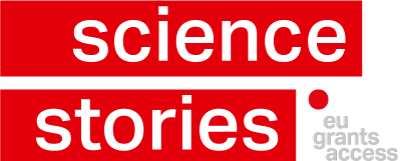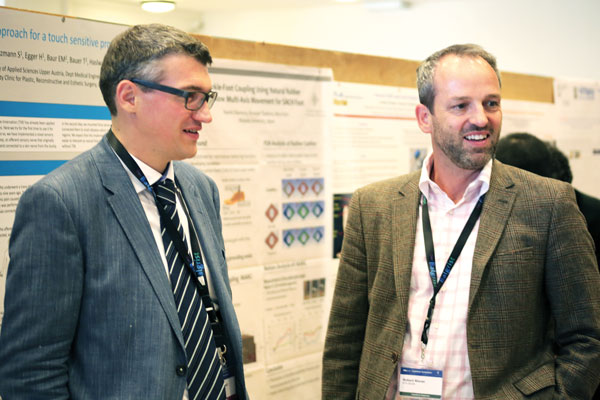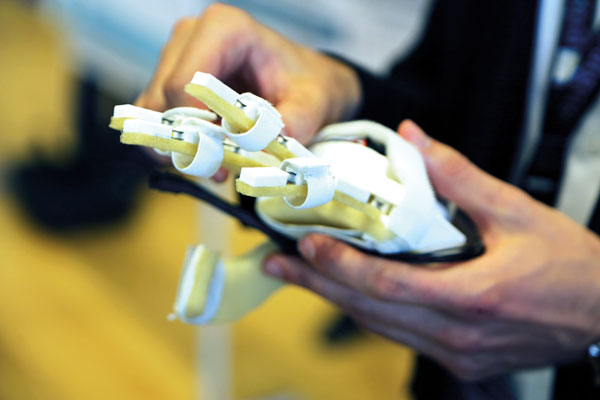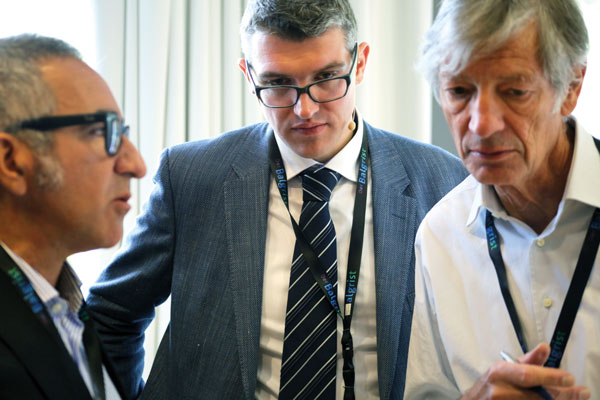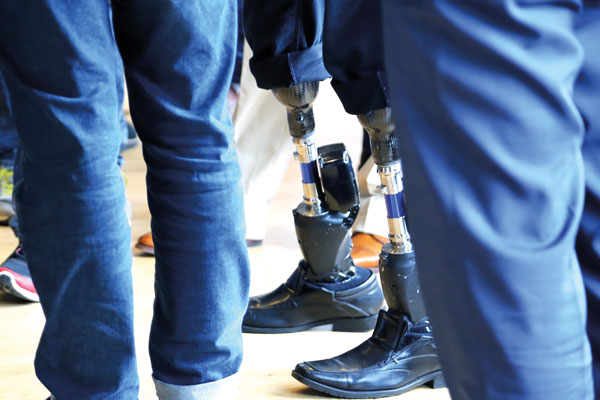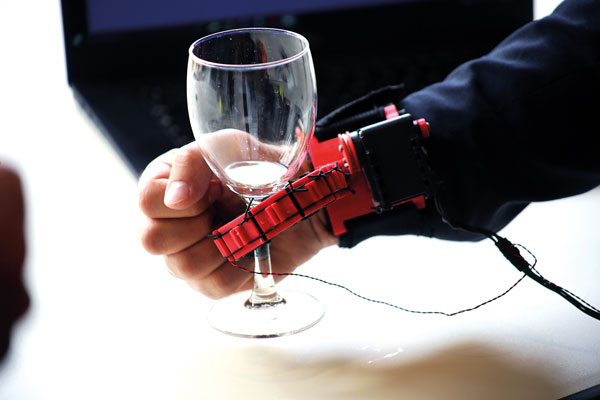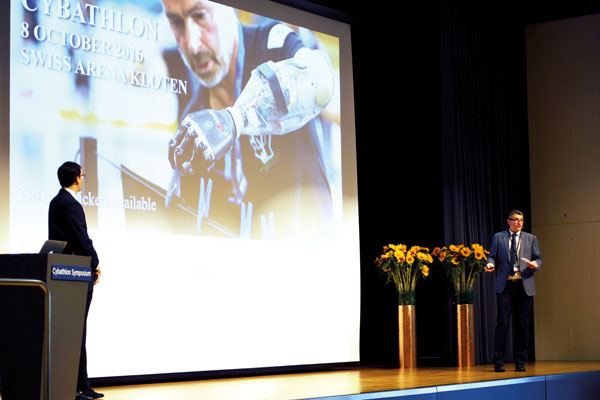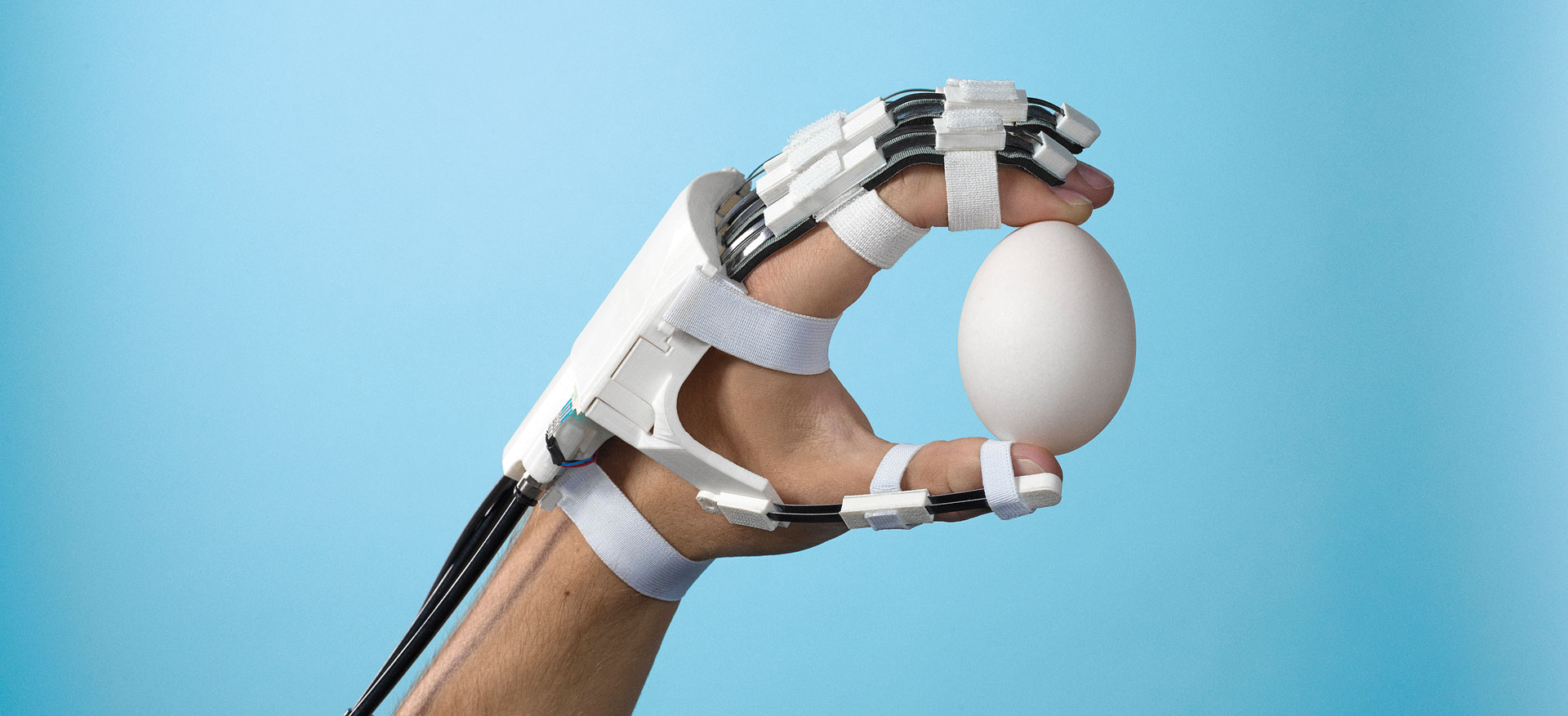
With a Little Help from Your Robot
Smart technologies for better therapies and prostheses
How Roger Gassert’s research could change the daily life of people with motor disabilities, why he considers it worthwhile to participate in a collaborative EU project and what impressed him most at the first Cybathlon Symposium.
There is an expectant silence when Roger Gassert steps onto the stage of the conference hall to open the Cybathlon Symposium. More than 300 researchers in rehabilitation engineering and assistive technologies have followed the invitation to join this scientific conference on assistive technology in Switzerland, among them many of the key players from the US, Japan and Europe.
«One way to reduce complexity
might be to learn from the body.»
An intensive day of keynote speeches, short talks, poster sessions and a panel discussion lies before them when the participants gather at the SWISS Arena in Kloten on this foggy morning in October 2016. The Cybathlon Symposium is the scientific preceding programme to the Cybathlon itself, the first championship for pilots with disabilities organised by ETH Zurich, which will take place two days later. Roger Gassert, Professor of Rehabilitation Engineering at ETH Zurich, together with his team, has been very much engaged in setting up the Cybathlon championship and is also in charge of the Cybathlon Symposium. He already had a busy time prior to opening the conference: Two days before, he and his team hosted the progress meeting of the SoftPro consortium, a collaborative Horizon 2020 project on rehabilitation technologies in which both ETH Zurich and the University of Zurich are participating. “We wanted to connect the Cybathlon competition with a scientific conference and also add the SoftPro meeting as there are strong links between the three events and several of the SoftPro groups presenting at the conference will also participate in the Cybathlon with a team,” Roger Gassert told us just before the conference started.
An interdisciplinary approach
In his lab for Rehabilitation Engineering, Roger Gassert and his team run a number of projects to promote the rehabilitation of patients affected by sensory-motor impairments due to a stroke or a spinal cord injury. His activities reach from basic research to understanding how we move our body and how this is affected by a stroke, to measurements of improvements in therapies up to the development of new therapeutic and assistive technologies. His team consists of engineers, psychologists and neuroscientists and he cooperates very closely with Andreas Luft, Co-Chair of the Clinic for Neurology and Professor of the University of Zurich at the University Hospital Zurich. The innovative measurement techniques Roger Gassert and his team have developed can be applied on Andreas Luft’s patients and the outcome of these measurements helps to develop new therapies and technologies. Therefore, when Roger Gassert was asked to join the SoftPro project, he suggested also including Andreas Luft, as he and his team fitted perfectly into the ambitious consortium of rehabilitation technology researchers, clinics and industry, and as the two groups look back on a long-lasting and successful translational collaboration.
Simpler, cheaper, smarter
SoftPro has the overall vision to make rehabilitation technology simpler, extra user-friendly, cheaper and more widely available to people who need it.
«For the progress of our research
it has been an enormous advantage
to have the main clinical collaborator,
the group of Andreas Luft,
just around the corner.»
There are already many sophisticated technologies but often patients or therapists hesitate to adopt them because the functions are too complex or not sufficiently robust. “One way to reduce complexity might be to learn from the body,” Roger Gassert tells us during the coffee break. “With our hand we can perform 30 or more grasps to manipulate objects. But when we analyse these movements in detail, there are only two or three basic patterns, which we modify slightly to adapt to the individual objects. We call these patterns synergies. Using this knowledge, we can build a hand prosthesis that performs only one of these basic patterns but can pick up different objects with only one movement, adapting to the object through a soft structure. That is what my colleagues from the University of Pisa and the IIT Genova have done.” To detect such synergies of movement, measurement plays a key role. And measurement is exactly Roger Gassert’s contribution to the SoftPro project. He and his team have developed a virtual version combining two standard clinical tests to assess how well a stroke-affected patient can perform movements by placing nine pegs in nine holes. In this virtual test version, the patient sits in front of a screen and inserts the pegs into the holes by manipulating a sophisticated computer mouse. With this device, the researchers can measure the position and the orientation of the hand as well as the grasping force 1000 times per second. The result is a comprehensive picture of the movements of the patient’s arm and hand, which permits to assess the effects of the therapies, to improve them but also to identify so-called synergies by testing healthy persons as well as “abnormal” synergies in patients. “For the progress of our research it has been an enormous advantage to have the main clinical collaborator, the group of Andreas Luft, just around the corner,” Roger Gassert says. “So we are already at the point when we can do measurements in patients. We can test our tools and hopefully pass them on to the other partners as the project progresses.” However, Roger Gassert explains the main benefit of participating in SoftPro as follows: “As we provide our assessment tests to the different partners of the project, we experience the excellent opportunity of collaborating with even more groups to establish our assessment and collect data from different clinics in multiple countries. We can thus enlarge our dataset, learn more about the pathologies and compare datasets from different clinics. This will greatly advance our efforts.” As the coffee break is over, Roger Gassert rushes back to the stage to prepare for the next session.
A felt part of the body
In the meantime, we have a look at the posters presented by several research groups. It is like glancing through a window at the future of rehabilitation and prosthetics. Robotics technologies are increasingly integrated into the body, linked to the nervous system and controlled by the brain. Thus, prostheses become a part of the body. Roger Gassert’s project on a wearable hand exoskeleton is very much in line with this trend. Later in the day, we ask him what impressed him most during this first Cybathlon Symposium. “Clearly some of the recent work of Hugh Herr,” he answers.
«I hope that some of the technologies
we develop will make it
to the patients and
improve their lives.»
Hugh Herr, head of the Biomechatronics research group at the MIT Media Lab, lost both his legs below the knee as a teenager but thanks to the sophisticated prostheses he developed, he can walk and move almost naturally. “What fascinated me about his work was the broad approach he presented,” Roger Gassert continues. “Hugh Herr not only looks at the technological aspects, but also at how to optimise the interface and control of the device, e.g. by developing novel amputation techniques together with surgeons. They shape the surface of the bone and tie the muscles in a way that the brain can move the muscles but also receive feedback from them which makes the prosthesis feel as a movable part of the body.” At the end of the Symposium, we ask Roger Gassert what he hopes to achieve by his own research. “I hope that some of the technologies we develop will make it to the patients and improve their lives,” he answers and leaves the conference hall to prepare for the Cybathlon.
Cybathlon
Cybathlon is a novel championship for pilots with disabilities that took place for the first time on 8 October 2016 at the SWISS Arena near Zurich. The pilots had to overcome challenges of daily life using novel assistive technologies in six different disciplines. In these first bionic Paralympics, 66 teams from various countries competed. They were observed by scientists, assistant technology developers, company representatives as well as a public audience of almost 5000 people and 150 journalists from national and international media. Swiss television broadcasted the event. The Cybathlon was initiated by Robert Riener, Professor of Sensory-Motor Systems at ETH Zurich, and organised by him and his colleagues and their teams from ETH Zurich. The event aimed for a better understanding of the challenges that people with disabilities face in their daily lives and for demonstrating how novel assistive technologies can improve their independence. The next Cybathlon will take place in four years.
Interview with Roger Gassert
Roger Gassert
Roger Gassert received the M.Sc. degree in microengineering and the PhD degree in neuroscience robotics from the École polytechnique fédérale de Lausanne (EPFL) in 2002 and 2006, respectively. His PhD was partially carried out at the ATR Computational Neuroscience Laboratories in Kyoto, Japan. He was a postdoctoral fellow at the Imperial College London and the Simon Fraser University in Vancouver, Canada, supported by the Swiss National Science Foundation. Since 2014, Roger Gassert is Associate Professor of Rehabilitation Engineering at the Department of Health Sciences and Technology at ETH Zurich.
Horizon 2020 - funded project
SoftPro: Synergy-based Open-source Foundations and Technologies for Prosthetics and RehabilitatiOn.
Objective: to increase the cumulative benefits of assistive robotic technologies using synergy models and soft robotics to develop novel user-friendly prostheses, exoskeletons and assistive devices for upper limb rehabilitation.
Participants: A total of 12 institutions including universities and enterprises from Europe.
Coordinator: Fondazione Istituto Italiano di Tecnologia (IIT) Genoa, Italy
